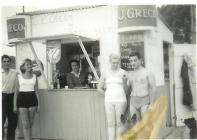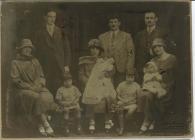Part 4 – Some local families and events
Items in this story:
I am a former lecturer in Computer Science and an author, in particular of novels inspired by my family heritage. I am very proud to be the product (one of seven products, in fact!) of an Italian father and a Welsh mother. I feel privileged to have experienced the Italian culture and the Welsh Culture at first hand! In recent years, I met up once again with my best friend from primary school after many years. She asked if I had ever noticed that she always turned up around the time we were having our evening meal. And no, I hadn’t. But she went on to explain how she loved coming to our home, not only because she knew she would be invited to join us, but because she loved seeing and eating the different types of food she had never seen before.
I have always felt that Italian people and Welsh people have so much in common; in terms of culture – a shared love of music and art – and a warmth of personality and ‘joie de vivre’ that is hard to find elsewhere. My father and one of my brothers were proficient in both the piano and the accordion, and my aunts played the mandolin. Our region of Italy, Picinisco, is famous for its zampogne, very similar to bagpipes, and which can still be heard there today. The Italians came to the UK in search of work, initially to the Dover and London areas, from where many later moved to Wales and Scotland. Initially, this was seasonal – organ grinders, musical bands, confectionery (mostly ice cream), hot chestnuts and potatoes. But later, the pull factor was local industry and the opportunity to set up their own businesses, usually in cafes, ice cream parlours and fish and chip shops.
It comes as no surprise then to find that during the major influx of Italians into Wales in the late 19th and early 20th centuries, and later during the 1950s, they were welcomed and absorbed into the valleys and towns of Wales, where many put down firm roots and their descendants remain even today. Little wonder then, that the ‘phone directory is littered with the musical and unmistakable names of Italy – Arcari, Pelosi, Demarco, Grilli, D’Ambrosio, Cascarini, Valerio, Capaldi, Zanetti, Avo, Greco - to name just a few. Many of these crop up again and again in my own family tree.
Most of the families from the area are interlinked. Hardly surprising, with a very small gene pool of around 1200. Indeed, the first mention of my family the Arcaris in the Parish Registers of Italy, is with the marriage of an Arcari to a Pelosi in the late 1500s. There have been many such marriages between the families since, and on a visit to the family home in 2009 we discovered that the Arcari farm, built in 1604, was in the next field to the Pelosi home. Four centuries later, Paulette Pelosi and I are still close friends here in South Wales, and living just a few miles away from each other.
My family, the Arcaris, had their first café at 77 Woodfield Street, Morriston, in the early 1900s, after first starting out in Kent. Later, they moved to High Street Swansea, where they had a café directly opposite the Pictorium, later named the Palace Theatre, which is now due for a major renovation project by the local council.
POMPAS – Morriston and Swansea (Thanks to Dominic Byrne)
Nascenza Pompa was the sister of Sabbatino Arcari. The Pompas came to Wales and Morriston in the late 1800s and opened up their café at Morriston Cross, Swansea. They also owned a second café on the corner of St Helen’s Road and Dillwyn Street, close to two other Italian cafes in Dillwyn Street, Macaris (fish and chips) and later Pelosis. Ferdinando Pompa, Nascenza’s husband, died tragically in the ill-fated Arandora Star incident during WWII.
GRECOS (Thanks to Paul Greco)
Another well-known Italian café in Morriston was owned by the Greco Family. Angelo Greco owned his first café in the Hafod, later followed by others in St Thomas, Swansea near the docks, another in High Street and the two in Morriston.
Angelo was living in the Arpino area of Italy, with his mum, dad, brother, and 2 sisters. His mum died and eventually , his father re married a widow who had two girls of her own that she doted on She turned out to be the typical nasty step mother to him and his brother etc, So while Angelo was still in his teens. He jumped ship and worked his passage over here, telling his brother and sisters that he would make his fortune and send for them. He arrived over here with nothing more than the clothes on his back, and a couple of recipes for bread and cake making and a recipe for Ice Cream! He started to make bread and cakes and sold them to other shops and off a tray, walking the streets. He also got himself a tricycle, from which( according to the local newspaper) he sold his Ice cream!
Angelo gave one of the Morriston cafes to his brother, Benedetto and the other to his son, Ernesto. Ernie and his wife Matilda, followed by their son John, would be the ones most Moriston people now would remember. Paul is the grandson of Ernie.
THE WAR YEARS
During the war, many of the acts of kindness and charity were sadly forgotten by some. The future of many of the Italian café owners was to be inextricably linked by the events that began to unfold. When Italy joined the war in1940, Churchill declared all Italian residents in the UK ‘enemy aliens’ and the reaction was almost immediate.
CASCARINIS IN THE WAR – NAME CALLING (Thanks to Paul Greco and Mr Zanetti)
Cascarini’s café, near High Street Station, was one of those attacked by a mob who smashed windows, looted the premises, and smashed up the interior. Their second café, at Port Tennant, was saved from a similar fate by a group of dockers who stood in front of the café, blocking the way of the mob. A group of around 200 gathered outside Segadelli’s café on Carmarthen Road, where police were forced to draw truncheons to prevent further looting.
Angelo Greco and Giuseppe Pelosi also had their cafes attacked, to name a few, with many others suffering physical and verbal abuse. Others, such as Zanetti’s, had their belongings and cafes confiscated by the authorities. Both parents were taken for questioning. The mother was frantic as she had two young children, a boy and a girl. She somehow managed to get a message to the family solicitor, who arranged for them to go to St Joseph’s convent (Now a hotel) for safe-keeping, where they remained for the duration of the war. Mrs Zanetti was released but spent the rest of the war lodging in St Helen’s Avenue, as the family café and home had been confiscated by the authorities. Mr Zanetti was interned, and sadly lost his life in the Arandora Star Tragedy.
INTERNMENT
It was understandable that there were deep concerns that there could be supporters of Mussolini in their midst, but the measures taken by the Government were nevertheless draconian. Most of the Italian families had lived in the UK for years and had made it their home, and many had taken British citizenship, with very little support for Mussolini, or appetite for his involvement with the war. Many were serving with the British forces.
The order was given for all Italian males between the ages of 16 – 70 to be brought in, initially for questioning. Women weren't exempt either, and many were arrested. Despite protestations that they were not interested in Fascism or Mussolini, they were rounded up, many at 3 am, and taken initially for questioning, later being transferred to transitional camps such as the filthy Warth Mills, awaiting deportation to Canada, Australia or the Isle of Man. Some were later released, but had to inform police regularly of their movements and were not allowed outside the area without special permission.
ARANDORA STAR
The Arandora Star was a converted Blue Star luxury liner, built in 1927 by Cammel Laird, bound for Canada from Liverpool. There was nothing to indicate that this was a civilian ship – no Red Cross displayed, she was painted battleship grey, there were three times more passengers than in peace time with many confined below deck, there was barbed wire around the rails and too few lifeboats for the number of passengers aboard. She set sail from Liverpool and early in the morning of following day, was torpedoed off the west coast of Ireland by a German U-Boat.
486 Italian men drowned, including Ferdinando Pompa, Francesco D’Ambrosio and Antonio Zanetti. Others like Angelo Greco and Giuseppe Pelosi, were forced to continue their journey just days later, many on the Dunera, despite being traumatised by the events. After their return to Wales, many refused to talk about their experiences for the rest of their lives. On July 2nd, 2010, a permanent Welsh memorial was unveiled in the Cathedral in Cardiff.
POST WAR
When the internees returned home to Wales, many found they had to start out all over again. Some rebuilt their businesses, others couldn't face starting afresh and simply looked for other work. What is never in doubt is that they saw this as their home
PoW Camp 70 at Henllan, near Newcastle Emlyn housed Italian PoWs – another story in its own right. In their case, some returned to Italy, but a few met local girls and loved the area so much, they decided to stay. The descendants of one of these PoW now has a thriving restaurant, ‘La Calabria’, near Henllan .
1950'S ONWARDS
This decade brought a fresh influx of Italian migrants, mainly searching for work with the Government running active recruitment drives in a bid to attract overseas labour. The coal mines and steel works throughout the UK were a big attraction and included the steel work at Margam, the coal industry and others in Wales. However, many followed in the footsteps of their entrepreneurial fore-runners and started their own businesses, mainly fish and chip shops, restaurants, ice cream parlours and the familiar espresso cafes, with the hissing coffee machines, hot pies and the ubiquitous juke box.
Written by Anita Arcari, for People’s Collection Wales, February 2020.






